Black & Decker LLP120 User Manual
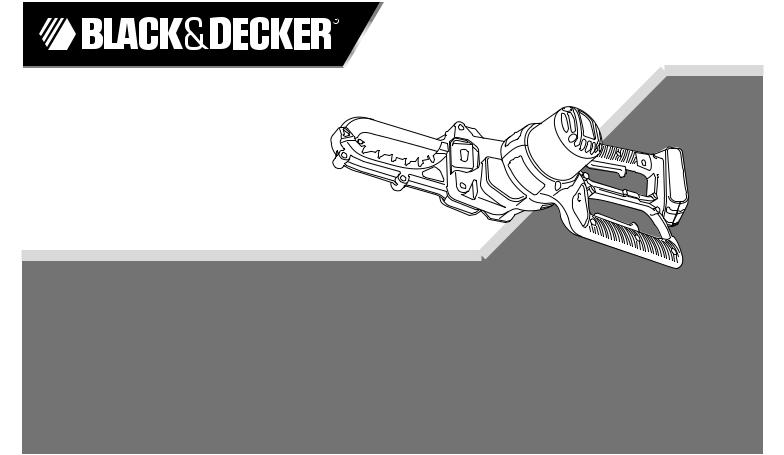
20v max* lithium alligator lopper
INSTRUCTION MANUAL
Catalog Number
LLP120
KEY INFORMATION YOU SHOULD KNOW:
•DO NOT OVER-TENSION CHAIN. Refer to “Chain Tension ADJUSTMENT” for proper method of tensioning chain.
•Retighten chain frequently during first two hours of use as chain breaks in.
Thank you for choosing Black & Decker! To register your new product go to www.BlackandDecker.com/NewOwner
Please read before returning this product for any reason.
If you have a question or experience a problem with your Black & Decker purchase, go to http://www.blackanddecker.com/instantanswers If you can’t find the answer or do not have access to the Internet, call 1-800-544-6986 from 8 a.m. to 5 p.m. EST Mon. - Fri. to speak with an agent. Please have the catalog number available when you call.
Save this manual for future reference.
VEA EL ESPANOL EN LA CONTRAPORTADA.
INSTRUCTIVO DE OPERACIÓN, CENTROS DE SERVICIO Y PÓLIZA DE GARANTÍA.
ADVERTENCIA: LÉASE ESTE INSTRUCTIVO ANTES DE USAR EL PRODUCTO.
*Maximum initial battery pack voltage (measured without a workload) is 20 volts. Measured under a workload, nominal voltage is 18.
1
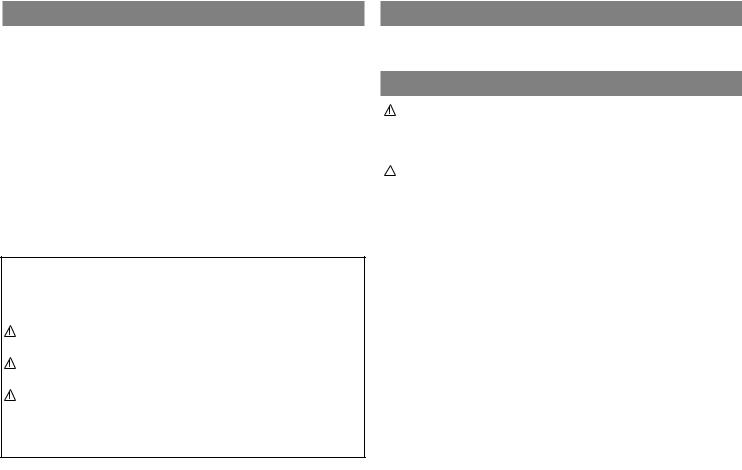
Table Of Contents |
Intended use |
Safety Guidelines - Definitions................................................. |
2 |
Important Safety Instructions.................................................... |
2 |
Important Safety Instructions for Battery Chargers.................. |
6 |
Components............................................................................. |
7 |
Important Safety Instructions for Battery Packs....................... |
8 |
Charging Procedure................................................................. |
9 |
Installing/Removing Battery Pack............................................. |
10 |
Preparing Lopper For Use........................................................ |
10 |
Operation.................................................................................. |
11 |
Maintenance............................................................................. |
13 |
Accessories.............................................................................. |
14 |
Service Information................................................................... |
14 |
Troubleshooting........................................................................ |
15 |
Limited Two-Year Home Use Warranty.................................... |
16 |
SAFETY GUIDELINES - DEFINITIONS
It is important for you to read and understand this manual. The information it contains relates to protecting YOUR SAFETY and PREVENTING PROBLEMS. The symbols below are used to help you recognize this information.
DANGER: Indicates an imminently hazardous situation which, if not avoided, will result in death or serious injury.
WARNING: Indicates a potentially hazardous situation which, if not avoided, could result in death or serious injury.
CAUTION: Indicates a potentially hazardous situation which, if not avoided, may result in minor or moderate injury.
CAUTION: Used without the safety alert symbol indicates a potentially hazardous situation which, if not avoided, may result in property damage.
Your Black & Decker Alligator LopperTM has been designed for pruning trees and cutting small logs up to 4 inches (100mm) in diameter. This tool is intended for consumer use only.
Important Safety Instructions
WARNING: When using a battery operated chain saw, basic safety precautions should always be followed to reduce risk of
fire, electric shock, and personal injury, including the following:
READ ALL INSTRUCTIONS
 Safety Instructions and Warnings for Chain Saws
Safety Instructions and Warnings for Chain Saws
• Keep Work Area Clean
Cluttered areas invite injuries. Do not start cutting until you have a clear work area, secure footing, and a planned retreat path from the falling tree.
• Consider Work Area Environment
Use extreme caution when cutting small size brush and saplings because the slender material may catch the saw chain and be whipped toward you or pull you off balance. When cutting a limb that is under tension be alert for spring back so that you will not be struck when the tension in the wood fibers is released. Do not expose chain saw to rain or snow. Do not use
chain saw in damp or wet locations or while it is raining or snowing. Do not use chain saw in the presence of flammable liquids or gases or enclosed concentrations of dust. Cut only when visibility and light are sufficient to see clearly
• Keep Children, Bystanders, Visitors and Animals Away
Do not let visitors contact chain saw. All visitors should be kept away from work area.
• Store Idle Chain Saw
When not in use, chain saws should be stored in a dry, and high or locked-up place - out of the reach of children. When storing saw, always remove battery and use a scabbard or carrying case.
• Don’t Grasp the exposed cutting blades or cutting edges when
2 picking up or holding the appliance.

• Don’t Force Chain Saw. It will do the job better and safer at the rate for which it was intended.
• Use Right Tool
Cut wood only. Don’t use chain saw for purpose not intended - for example - Don’t use chain saw for cutting plastic, metal, masonry, non-wood building materials.
• Dress Properly
Do not wear loose clothing or jewelry. Keep your hair, clothing, and gloves away from moving parts. Loose clothing, jewelry, or long hair can be caught in moving parts. Wear protective hair covering to contain long hair. Air vents cover moving parts and should be avoided. Protective non-slip gloves and non-skid footwear are recommended when working outdoors. Always wear heavy, long pants or other protection for your legs.
• Use Safety Glasses
Also use safety footwear; snug fitting clothing; protective gloves; proper hearing, respiratory, and head protection.
• Carrying Saw
Carry the chain saw by the front handle with the saw stopped, finger off the switch, the guide bar and saw chain to the rear. Remove battery and secure latch when transporting saw.
• Maintain Chain Saw With Care
Keep tools sharp and clean for better and safer performance. Follow instructions for lubricating and changing accessories. Keep handles dry, clean, and free from oil and grease.
• Disconnect Battery
Disconnect battery from chain saw when not in use, before servicing, when tensioning chain, and when changing accessories and attachments, such as saw chain.
• Stay Alert
Watch what you are doing. Use common sense. Do not operate chain saw when you are tired, ill, or under the influence of alcohol, drugs, or medication. Keep all parts of the body away from the saw chain when the motor is operating. Before you start the saw, make sure the saw chain is not contacting anything. When cutting through wood, remember the chain saw cuts quickly and will continue its downward or upward path. Stay out of its path.
• Check Damaged Parts
Before further use of the chain saw, any part that is damaged should be carefully checked to determine that it will operate properly and perform its intended function. Check for alignment of moving parts, binding of moving parts, breakage of parts, mounting, and any other conditions that may affect its operation. A guard or other part that is damaged should be properly repaired or replaced by an authorized service center unless otherwise indicated elsewhere in this instruction manual. Have defective switches replaced by authorized service center. Do not use chain saw if switch does not turn it on and off. Do not operate a chain saw that is damaged, improperly adjusted, or is not completely and securely assembled. Be sure that the saw chain stops moving when the trigger is released.
• Guard Against Kickback
WARNING: KICKBACK may occur when the nose or tip of the guide bar touches an object, or when the wood closes in and
pinches the saw chain in the cut. Tip contact in some cases may cause a lightning fast reverse reaction, kicking the guide bar up and back towards the operator. Pinching the saw chain along the top of the guide bar may push the guide bar rapidly back towards the operator. Either of these reactions may cause you to lose control of the saw which could result in serious injury to user.
The following precautions should be followed to minimize kickback:
(1.) Grip Saw Firmly. Hold the chain saw firmly with both hands when the motor is running. Use a firm grip with thumbs and fingers encircling the chain saw handles. Chain saw will pull forward when cutting on the bottom edge of the bar, and push backward when cutting along the top edge of the bar.
(2.) Do not over reach.
(3.) Keep proper footing and balance at all times.
(4.) Don’t let the nose of the guide bar contact a log, branch, ground or other obstruction.
(5.) Don’t cut above shoulder height.
(6.) Use devices such as low kickback chain and reduced kickback guide bars that reduce the risks associated with kickback.
(7.) Only use replacement bars and chains specified by the 3 manufacturer or the equivalent.

(8.) Never let the moving chain contact any object at the tip of the guide bar.
(9.) Keep the working area free from obstructions such as other trees, branches, rocks, fences, stumps, etc. Eliminate or avoid any obstruction that your saw chain could hit while you are cutting through a particular log or branch.
(10.) Keep your saw chain sharp and properly tensioned. A loose or dull chain can increase the chance of kickback. Check tension at regular intervals with the motor stopped and battery removed, never with the motor running.
(11.) Begin and continue cutting only with the chain moving at full speed. If the chain is moving at a slower speed, there is a greater chance for kickback to occur.
(12.) Cut one log at a time.
(13.) Use extreme caution when re-entering a previous cut. Engage ribbed bumpers into wood and allow chain to reach full speed before proceeding with cut.
(14.) Do not attempt plunge cuts or bore cuts.
(15.) Watch for shifting logs or other forces that could close a cut and pinch or fall into chain.
• Power Supply
Connect chain saw battery charger to correct voltage, that is, be sure that the voltage supplied is the same as that specified on the nameplate of the tool.
Additional safety instructions for the AlligatorTM Lopper
 WARNING: Never use the tool above shoulder height. Always position yourself out of the path of falling branches and debris.
WARNING: Never use the tool above shoulder height. Always position yourself out of the path of falling branches and debris.
 WARNING: Do not use this tool to fell trees.
WARNING: Do not use this tool to fell trees.
-Pre-plan a safe exit from falling branches and debris. Ensure the exit route is clear of obstacles that would prevent or hinder movement. Remember wet grass and freshly cut bark is slippery.
-Be aware of the direction that a branch may fall. Consider all conditions that may affect the direction of fall, including:
- The intended direction of fall. - The natural lean of the branch.
- Any unusual heavy limb structure or decay.
- Surrounding trees and obstacles including overhead lines. - The wind speed and direction.
- The safe distance between a branch and debris to be felled and bystanders, buildings and other objects is at least 2 1/2 times the length of the branch. Any bystander, building or object within this distance is at risk from being struck by the falling branch.
- When cutting a limb that is under tension be aware of spring back. When the tension in the wood fibres are released the spring loaded limb may strike the operator and/or throw the tool out of control.
- Always wear suitable safety equipment such as non-skid heavy-duty shoes, goggles, ear protection and gloves when operating the tool.
- Ensure someone is nearby (at a safe distance) in case of an accident. - Do not attempt to operate the tool when in a tree, on a ladder or standing on any other unstable support.
- Keep proper footing and balance at all times.
- Hold the tool firmly with both hands when the motor is running.
- Keep handles dry, clean and free from oil and grease. Greasy oily handles are slippery causing loss of control.
- Do not let the moving chain contact any object at the tip of the guide bar. - Keep your saw chain properly tensioned. Check tension at regular intervals with the motor stopped and battery disconnected.
- Begin and continue cutting only with the chain moving at full speed. - Watch for shifting branches or other forces that could close a cut and pinch or fall into the chain.
- Use extreme caution when re-entering a previous cut. Engage spikes on lower jaw into wood and allow the chain to reach full speed before proceeding with cut.
4
- Use of this tool for operation different to those intended could result in hazardous situations. Cut wood only. Don’t use this tool for purposes not intended - for example - Don’t use tool for cutting

plastic, masonry or non-wood building materials.
- If any debris gets caught with the guard or tool discontinue use, disconnect power cord and clear debris.
- Worn chains and chain guide bars should be replaced.
- Only use replacement bars and chains specified by the manufacturer. - This saw is intended for infrequent use by homeowners, cottagers, and campers, and for such general applications as clearing, pruning, cutting firewood, etc. It is not intended for prolonged use. Prolonged periods of operation can cause circulatory problems in the user’s hands due to vibration. For such use, it may be appropriate to use a saw having an anti-vibration feature.
Kickback Safety Features
Guard against kickback. Kickback is the upward motion of the guide bar that occurs when the saw chain, at the nose of the guide bar, contacts an object. Kickback can lead to dangerous loss of control of the chain saw.
WARNING: The following features are included on your Alligator LopperTM to help reduce the hazard of kickback;
however such features will not totally eliminate this dangerous reaction. As a chain saw user do not rely only on safety devices. You must follow all safety precautions, instructions, and maintenance in this manual to help avoid kickback and other forces which can result in serious injury.
Top Jaw - This has been designed specifically to cover the tip of the chain bar where the danger zone for kickback occurs. In the event of any kickback the guard also helps reduce the risk of the chain coming into contact with the operator.
Reduced Kickback Guide Bar - This has been designed with a small radius tip which reduces the size of the kickback zone on the bar tip. Reduced Kickback Chain - Designed with a contoured depth gauge and guard link which deflect kickback force and allows wood to gradually ride into the cutter.
Electrical safety
This tool and charger is double insulated; therefore no grounding wire is required. Always check that the power supply corresponds to the voltage on the rating plate.
 WARNING: Some dust created by power sanding, sawing, grinding, drilling, and other construction activities contains
WARNING: Some dust created by power sanding, sawing, grinding, drilling, and other construction activities contains
chemicals known to cause cancer, birth defects or other reproductive harm. Some examples of these chemicals are:
• lead from lead-based paints,
• crystalline silica from bricks and cement and other masonry products, and
• arsenic and chromium from chemically-treated lumber. (CCA)
Your risk from these exposures varies, depending on how often you do this type of work. To reduce your exposure to these chemicals: work in a well ventilated area, and work with approved safety equipment, such as those dust masks that are specially designed to filter out microscopic particles.
• Avoid prolonged contact with dust from power sanding, sawing, grinding, drilling, and other construction activities. Wear protective clothing and wash exposed areas with soap and water. Allowing dust to get into your mouth, eyes, or lay on the skin may promote absorption of harmful chemicals.
 WARNING: Use of this tool can generate and/or disburse dust, which may cause serious and permanent respiratory or
WARNING: Use of this tool can generate and/or disburse dust, which may cause serious and permanent respiratory or
other injury. Always use NIOSH/OSHA approved respiratory protection appropriate for the dust exposure. Direct particles away from face and body.
 CAUTION: Wear appropriate personal hearing protection during use. Under some conditions and duration of use, noise
CAUTION: Wear appropriate personal hearing protection during use. Under some conditions and duration of use, noise
from this product may contribute to hearing loss.
5
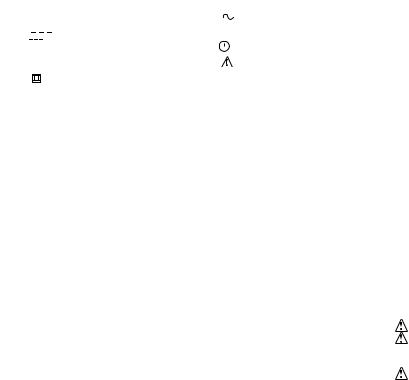
Symbols |
|
|
|
|
|
• Kickback, Rotational - The rapid upward and backward motion |
|||||
The label on your tool may include the following symbols. |
|
of the saw which can occur when the moving saw chain near the |
|||||||||
The symbols and their definitions are as follows: |
|
upper portion of the tip of the guide bar contacts an object, such as |
|||||||||
V................. volts |
A...........amperes |
|
a log or branch. |
||||||||
Hz............... hertz |
W..........watts |
|
• |
Low-Kickback Chain - A chain that complies with the kickback |
|||||||
min............. minutes |
|
|
|
........alternating current |
|
performance requirements of ANSI B175.1-1991 (when tested on a |
|||||
|
|
|
|
........... direct current |
no.........no load speed |
|
representative sample of chain saws.) |
||||
|
|
|
|
|
• Normal Cutting Position - Those positions assumed in |
||||||
|
|
|
............... Class I Construction |
|
|
|
.........earthing terminal |
|
|||
|
|
|
|
|
|
|
performing the bucking and felling cuts. |
||||
|
|
|
|
|
|
|
|||||
|
|
|
|
|
|
|
|||||
|
|
|
|
|
|
|
|||||
|
|
|
|
(grounded) |
|
|
|
.......safety alert symbol |
|
• |
Reduced Kickback Guide Bar - A guide bar which has been |
|
|
|
............... Class II Construction |
.../min or rpm...revolutions or |
|
demonstrated to reduce kickback significantly. |
|||||
|
|
|
|
(double insulated) |
|
|
|
reciprocation per minute |
|
• |
Replacement Saw Chain - A chain that complies with kickback |
|
|
|
|
|
|
|
|
|
|
performance requirements of ANSI B175.1-1991 when tested |
|
|
|
|
|
CHAIN SAW NAMES AND TERMS |
|
with specific chain saws. It may not meet the ANSI performance |
|||||
|
|
|
|
|
|
|
|
|
|
requirements when used with other saws. |
|
• Bucking - The process of cross cutting a felled tree or log into lengths. |
|
||||||||||
|
• |
Saw Chain - A loop of chain having cutting teeth, that cut the |
|||||||||
• Chain Brake - A device used to stop the chain saw. |
|
wood and that is driven by the motor and is supported by the guide bar. |
|||||||||
• Chain Saw Powerhead - A chain saw without the saw chain and |
|
• |
Switch - A device that when operated will complete or interrupt an |
||||||||
guide bar. |
|
|
|
|
|
electrical power circuit to the motor of the chain saw. |
|||||
• Clutch - A mechanism for connecting and disconnecting a driven |
|
• |
Switch Linkage - The mechanism that transmits motion from a |
||||||||
member to and from a rotating source of power. |
|
trigger to the switch. |
|||||||||
• Drive Sprocket or Sprocket - The toothed part that drives the |
|
|
|
||||||||
saw chain. |
|
|
|
|
|
|
important safety instructions for |
||||
• Felling - The process of cutting down a tree. |
|
|
battery chargers |
||||||||
• Felling Back Cut - The final cut in a tree felling operation made on |
|
|
|
||||||||
|
SAVE THESE INSTRUCTIONS:This manual contains important |
||||||||||
the opposite side of the tree from the notching cut. |
|
||||||||||
• Guide Bar - A solid railed structure that supports and guides the saw chain. |
|
safety instructions for battery chargers. |
|||||||||
• Kickback - The backward or upward motion, or both of the guide |
|
• Before using charger, read all instructions and cautionary markings |
|||||||||
bar occurring when the saw chain near the nose of the top area of |
|
|
on charger, battery pack, and product using battery pack. |
||||||||
the guide bar contacts any object such as a log or branch, or when |
|
|
WARNING: Shockhazard.Do not allow any liquid to get inside charger. |
||||||||
the wood closes in and pinches the saw chain in the cut. |
|
|
CAUTION: Burn hazard.To reduce the risk of injury, charge |
||||||||
• Kickback, Pinch - The rapid pushback of the saw which can |
|
only designated Black & Decker batteries. Other types of batteries |
|||||||||
occur when the wood closes in and pinches the moving saw chain |
|
may burst causing personal injury and damage. |
|||||||||
|
|
CAUTION: Under certain conditions, with the charger plugged |
|||||||||
in the cut along the top of the guide bar. |
6 |
|
in to the power supply, the charger can be shorted by foreign |
||||||||
|
|
|
|
|
|
|
|
|
|
|
|
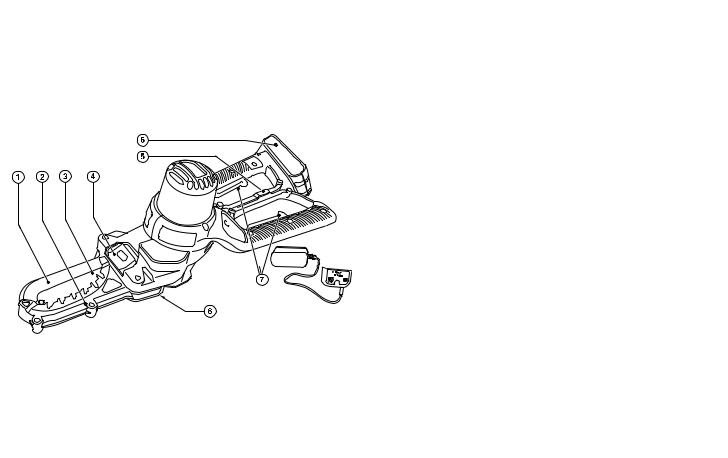
Components
Functional Description |
5. |
Latch |
|
(Fig A) |
|||
1. |
Top jaw |
6. |
Battery Pack |
2. |
Lower jaw |
7. |
On/off switch actuators |
3. |
Chain guide bar |
8. |
Chipping ejection point |
4. |
Oiling cover |
9. |
Charger |
A |
These products use the batteries and chargers listed in the chart below.
Description |
Catalog # |
|
20v |
Max* Lithium-Ion Battery: |
LBXR20 |
20v |
Max* Type 1 22wh Lithium-Ion Battery: |
LB20 |
20v |
Max* Lithium-Ion Battery Charger: |
LCS20 |
Lithium 2 Amp Fast Charger: |
L2AFC |
|
Lithium 2 Amp Fast Charger: |
L2AFCBST |
|
20v |
Max* Lithium-Ion Battery Charger: |
LCS1620 |
material. Foreign materials of a conductive nature such as, but not |
||||||||
limited to, steel wool, aluminum foil, or any buildup of metallic |
||||||||
particles should be kept away from charger cavities. Always unplug |
||||||||
the charger from the power supply when there is no battery pack in |
||||||||
the cavity. Unplug charger before attempting to clean. |
||||||||
• |
The charger supplied with this product is intended to be |
|||||||
|
plugged in such that it is correctly orientated in a vertical or |
|||||||
• |
floor mount position. |
|
|
|
|
|||
DO NOT attempt to charge the battery pack with any chargers |
||||||||
|
other than the ones in this manual. The charger and battery |
|||||||
• |
pack are specifically designed to work together. |
|
|
|||||
These chargers are not intended for any uses other than |
||||||||
|
charging designated Black & Decker rechargeable batteries. |
|||||||
• |
Any other uses may result in risk of fire, electric shock or electrocution. |
|||||||
Do not expose charger to rain or snow. |
|
|
||||||
• |
Pull by plug rather than cord when disconnecting charger. |
|||||||
• |
This will reduce risk of damage to electric plug and cord. |
|||||||
Make sure that cord is located so that it will not be stepped |
||||||||
• |
on, tripped over, or otherwise subjected to damage or stress. |
|||||||
Do not use an extension cord unless it is absolutely |
||||||||
|
necessary. Use of improper extension cord could result in risk of |
|||||||
• |
fire, electric shock, or electrocution. |
|
|
|
||||
An extension cord must have adequate wire size (AWG |
||||||||
|
or American Wire Gauge) for safety. The smaller the gauge |
|||||||
|
number of the wire, the greater the capacity of the cable, that is 16 |
|||||||
|
gauge has more capacity than 18 gauge. When using more than |
|||||||
|
one extension to make up the total length, be sure each individual |
|||||||
|
extension contains at least the minimum wire size. |
|||||||
|
Recommended Minimum Wire Size for Extension Cords |
|||||||
|
|
|
|
|
|
|||
|
|
Volts |
|
Minimum Gauge for Cord Sets |
||||
|
|
|
0-25 |
Total Length of Cord in Feet |
||||
|
|
120V |
|
26-50 |
51-100 101-150 |
|
||
|
|
Ampere Rating(0-7,6m) (7,6-15,2m) (15,2-30,4m) (30,4-45,7m) |
||||||
|
|
More |
Not more |
American Wire Gauge |
|
|
||
|
|
Than |
Than |
18 |
16 |
14 |
12 |
|
|
6 - |
10 |
|
|||||
7
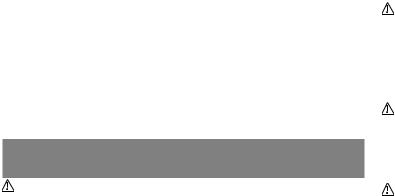
•Do not place any object on top of charger or place the charger on a soft surface that might block the ventilation slots and result in excessive internal heat. Place the charger in a position away from any heat source. The charger is ventilated through slots in the top and the bottom of the housing.
•Do not mount charger on wall or permanently affix charger to any surface. The charger is intended to use on a flat, stable surface (i.e., table top, bench top).
•Do not operate charger with damaged cord or plug — have them replaced immediately.
•Do not operate charger if it has received a sharp blow, been dropped, or otherwise damaged in any way. Take it to an authorized service center.
•Do not disassemble charger; take it to an authorized service center when service or repair is required. Incorrect reassembly may result in a risk of electric shock, electrocution or fire.
•Disconnect the charger from the outlet before attempting any cleaning. This will reduce the risk of electric shock. Removing the battery pack will not reduce this risk.
•NEVER attempt to connect 2 chargers together.
•The charger is designed to operate on standard household electrical power (120 Volts). Do not attempt to use it on any other voltage.
SAVE THESE INSTRUCTIONS
Important safety warnings for battery packs
WARNING: For safe operation, read this manual and manuals originally supplied with tool before using the charger.
The battery pack is not fully charged out of the carton. Before using the battery pack and charger, read the safety instructions below. Then follow charging procedures outlined.
Read all Instructions
• |
Do not incinerate the battery pack even if it is severely |
|
damaged or is completely worn out. The battery pack can |
|
explode in a fire. Toxic fumes and materials are created when |
• |
battery packs are burned. |
Do not charge or use battery in explosive atmospheres, such |
|
|
as in the presence of flammable liquids, gases or dust.Inserting |
• |
or removing the battery from the charger may ignite the dust or fumes. |
If battery contents come into contact with the skin, immediately |
|
|
wash area with mild soap and water. If battery liquid gets into the |
|
eye, rinse water over the open eye for 15 minutes or until irritation |
|
ceases. If medical attention is needed, the battery electrolyte for |
|
Li-ion batteries is composed of a mixture of liquid organic |
• |
carbonates and lithium salts. |
Contents of opened battery cells may cause respiratory |
|
|
irritation.Provide fresh air. If symptoms persist, seek medical attention. |
|
WARNING: Burn hazard. Battery liquid may be flammable if |
exposed to spark or flame. |
|
• |
Charge the battery packs only in Black & Deckerchargers. |
• |
DO NOT splash or immerse in water or other liquids.This may |
• |
cause premature cell failure. |
Do not store or use the tool and battery pack in locations where |
|
|
the temperature may reach or exceed 105°F (40˚C) (such as |
outside sheds or metal buildings in summer).
WARNING: Never attempt to open the battery pack for any reason. If battery pack case is cracked or damaged, do not insert into charger. Do not crush, drop or damage battery pack. Do not use a battery pack or charger that has received a sharp blow, been dropped, run over or damaged in any way (i.e., pierced with a nail, hit with a hammer, stepped on). Damaged battery packs should be returned to service center for recycling.
WARNING: Fire hazard. Do not store or carry battery so that metal objects can contact exposed battery terminals.For example, do not place battery in aprons, pockets, tool boxes, product kit boxes, drawers, etc., with loose nails, screws, keys, etc.
Transporting batteries can possibly cause fires if the battery terminals inadvertently come in contact with conductive materials such as keys, coins, hand tools and the like.The US Department
8 of Transportation Hazardous Material Regulations (HMR) actually

prohibit transporting batteries in commerce or on airplanes (i.e., packed in suitcases and carry-on luggage) UNLESS they are properly protected from short circuits. So when transporting individual batteries, make sure that the battery terminals are protected and well insulated from materials that could contact them and cause a short circuit.
NOTE: LI-ION batteries should not be put in checked baggage.
Storage Recommendations
1. The best storage place is one that is cool and dry away from direct sunlight and excess heat or cold.
2. Long storage will not harm the battery pack or charger.
Charging Procedure
The standard charger provided will charge a fully depeleted battery |
|
in about 4 hours. |
|
1. Plug the charger into an |
B |
appropriate outlet before inserting |
|
the battery pack. |
|
2. Insert the battery pack into the |
|
charger as shown in figure B. |
|
3. The green LED will flash |
|
indicating that the battery is being |
|
charged. |
|
4. The completion of charge |
|
is indicated by the green LED |
|
remaining on continuously. The |
|
pack is fully charged and may be |
|
used at this time or left on the charger. |
|
Recharge discharged batteries as soon as possible after use or |
|
battery life may be greatly diminished. It is recommended that the |
|
batteries be recharged after each use. |
|
Leaving the battery in the charger
The charger and battery pack can be left connected with the green LED glowing indefinitely. The charger will keep the battery pack fresh and fully charged.
Important Charging Notes
1. Longest life and best performance can be obtained if the battery pack is charged when the air temperature is between 60°F and 80°F (16°- 27°C). DO NOT charge the battery pack in an air temperature below +40°F (+4.5°C), or above +105°F (+40.5°C). This is important and will prevent serious damage to the battery pack.
2. The charger and battery pack may become warm to touch while charging. This is a normal condition, and does not indicate a
problem. To facilitate the cooling of the battery pack after use, avoid placing the charger or battery pack in a warm environment such as in a metal shed, or an uninsulated trailer.
3. If the battery pack does not charge properly:
a. Check current at receptacle by plugging in a lamp or other appliance.
b. Check to see if receptacle is connected to a light switch which turns power off when you turn out the lights.
c. Move charger and battery pack to a location where the surrounding air temperature is approximately 60°F and 80°F (16°- 27°C).
d. If charging problems persist, take the tool, battery pack and charger to your local service center.
4. The battery pack should be recharged when it fails to produce sufficient power on jobs which were easily done previously. DO NOT CONTINUE to use under these conditions. Follow the charging procedure. You may also charge a partially used pack whenever you desire with no adverse affect on the battery pack.
5. Foreign materials of a conductive nature such as, but not limited to, steel wool, aluminum foil, or any buildup of metallic particles should be kept away from charger cavities. Always unplug the charger from the power supply when there is no battery pack in the cavity. Unplug charger before attempting to clean.
6. Do not freeze or immerse charger in water or any other liquid.
WARNING: Shock hazard. Do not allow any liquid to get inside charger. Never attempt to open the battery pack for any reason. If the plastic housing of the battery pack breaks or cracks, return to a service center for recycling.
9
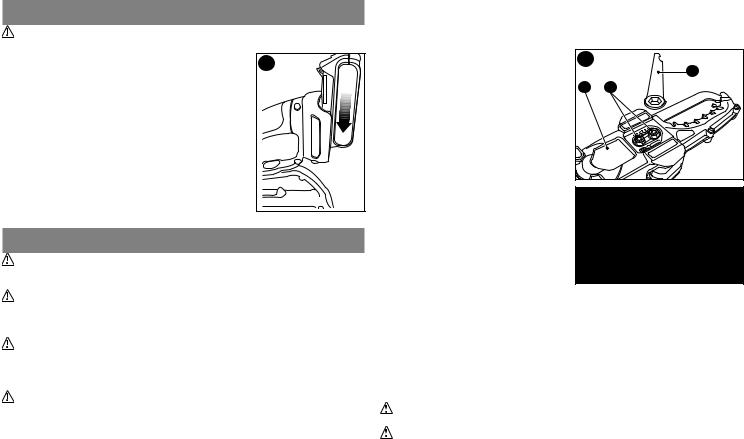
Installing / Removing Battery Pack
WARNING: Make certain the lock-off button is engaged to prevent switch actuation before removing or installing battery.
To install battery pack: Insert battery |
C |
pack into tool until an audible click is heard |
|
(figure C). |
|
To remove battery pack: Depress the |
|
battery release button in the back of the battery |
|
pack and pull battery pack out of tool. |
|
Preparing AlLigator Lopper For Use
WARNING: Read and understand all instructions. Failure to follow all instructions listed below may result in electric shock, fire and/or serious personal injury
WARNING: Sharp moving blade. To prevent accidental operation, ensure that the battery is disconnected from the tool before performing the following operations. Failure to do this could result in serious personal injury.
CAUTION: Sharp moving blade. Always wear protective gloves when installing or removing the chain.The chain is sharp and can cut you when it is not running.
Chain tension adjustment
WARNING: Before chain or other adjustments, make sure that the battery is disconnected from the tool.
If the chain cannot be correctly tensioned, it may need to be replaced. Contact your nearest service center.
The product comes ready assembled. However we recommend that
you check the tension of the chain, and chain retention bolts before |
|||
use and if required adjust. |
|
|
|
Checking and adjusting the chain tension (figs. D, E) |
|||
To tension the chain slacken the |
|
D |
|
two chain cover retention bolts |
|
12 |
|
(11) with the wrench (12) and the |
13 11 |
||
atuomatic chain tensioning device |
|
||
(fig E) will push the chain bar |
|
|
|
out, setting the correct tension. |
|
|
|
Retighten the two retention bolts |
|
|
|
(11) securely. |
|
|
|
Check that the correct tension has |
|
|
|
been set by lightly pulling on the |
|
|
|
chain. The tension is correct when |
|
|
|
the chain snaps back after being |
|
|
|
pulled 1/8 inch (3 mm) away from |
|
E |
|
the guide bar. There should be no |
|
|
|
“sag” between the guide bar and |
|
|
|
chain on the underside. |
|
|
|
Note: Do not over tension the chain |
|
|
|
as this will lead to excessive wear |
|
|
|
and reduce the life of the bar and |
|
|
|
chain. It will also lead to reduced |
|
|
|
product performance. |
|
|
|
Note: With first use and when the chain is new, check tension |
|||
frequently as a new chain stretches slightly. |
|
||
Replacing the chain and chain bar |
|
||
After prolonged use the chain and / or chain bar may need |
|||
replacing. Use Black & Decker replacement chain RC600 only. |
|||
Low-Kickback saw chain is a chain which has met the kickback |
|||
performance requirements of ANSI B175.1 when tested on the |
|||
representative sample of chain saws. |
|
|
|
Removing the saw chain & chain bar (figs.F, G) |
|||
WARNING: Before chain or other adjustments, make sure |
|||
that the battery is disconnected from the tool. |
|
||
WARNING: Laceration hazard. |
Always wear protective gloves |
||
when installing or removing the saw chain. The saw chain is sharp
10
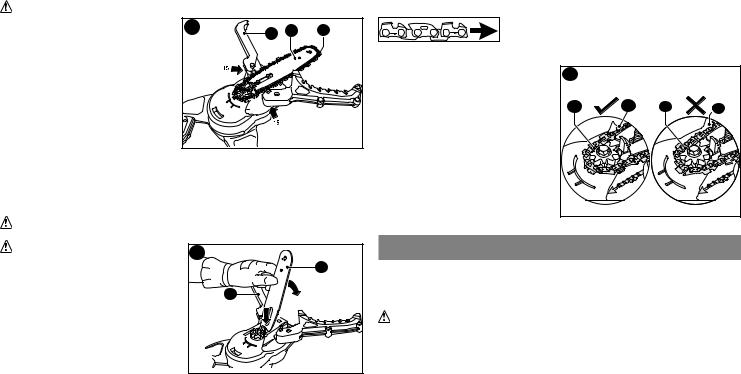
and can cut you when it is not running. |
|
|
||
|
WARNING: Burn hazard. The chain guide bar and chain may |
|||
become hot during use. Allow to |
F |
1 3 |
14 |
|
cool before adjustment or |
||||
removal. |
|
|
|
|
- |
Place the tool on a firm surface. |
|
|
|
- |
Rotate the two retention bolts |
|
|
|
(11) counter clockwise with |
|
|
|
|
wrench (12) provided and remove |
|
|
|
|
completely. |
|
|
|
|
- Remove the chain access |
|
|
|
|
cover (13). |
|
|
|
|
- |
Open the handles and pull back |
|
|
|
the top chain cover jaw (1). |
|
|
|
|
- |
Pull back chain bar (3) and then lift the saw chain (14) out of the |
|||
groove in the guide bar. The chain (14) can then be removed from |
||||
the unit. |
|
|
|
|
- |
The chain bar can then be angled up. |
|
|
|
Assembling the chain bar and chain (figs. G,H) |
||||
|
WARNING: Before chain or other adjustments, make sure |
|||
that the battery is disconnected from the tool. |
|
|
||
|
WARNING: Always wear |
G |
|
|
protective gloves when installing or |
|
3 |
||
removing the saw chain. The saw |
|
|
||
chain is sharp and can cut you |
1 |
|
|
|
when it is not running. |
|
|
||
- |
Ensure the operation is carried |
|
|
|
out on a firm surface. |
|
|
|
|
- |
Open the handles and pull back |
|
|
|
the top jaw (1). |
|
|
|
|
- |
Insert the chain bar into the |
|
|
|
space between the chain tensioner |
|
|
|
|
and align with the chain bar |
|
|
|
|
locator, angle the chain bar down ensuring it is correctly located. |
||||
- |
Place the chain (14) around the front of the chain bar and engage |
|||
in the nose sprocket of the chain bar. Make sure chain is installed properly, with the cutting teeth facing forward as shown here.
- Pull the chain bar and chain |
H |
|
|
|
back, engaging it in the groove in |
|
|
|
|
the chain bar and then over the |
|
|
|
|
sprocket (15) positioning teeth |
15 |
14 |
15 |
14 |
in the correct position on the |
||||
sprocket. |
|
|
|
|
- Replace the chain access cover |
|
|
|
|
(13) and retention bolts (11) |
|
|
|
|
tightening securely. |
|
|
|
|
Operation
Never operate a chain saw that is damaged or improperly adjusted or that is not completely and securely assembled. Be sure that the saw chain stops moving when the power control system triggers are released. Never adjust the guide bar or saw chain when the engine is operating.
WARNING: Let the tool work at its own pace. Do not overload. - Carry out regular cleaning of the unit as described in the maintenance section and in particular cleaning inside the chain access cover.
- The lower guard jaw (2) and top jaw (1) are designed to close when one of the handles is released or when the piece of branch being cut has been cut. If this does not occur, discontinue use of the tool and remove the battery pack. Check if any debris is blocking movement. To help in this process it may be necessary to remove chain access cover(13). If on assembly the problem is still present
11 take the unit to a service center.
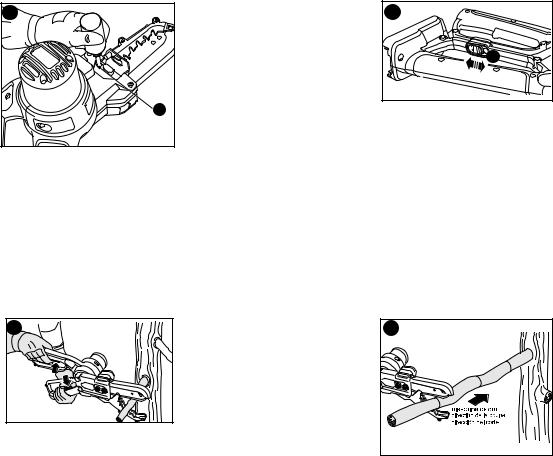
Oiling (fig. I) |
I |
A high quality bar and chain oil or |
|
SAE30 weight motor oil should be |
|
used for chain and bar lubrication. |
|
The use of a vegetable based bar |
|
and chain oil is recommended when |
|
pruning trees. Never use waste oil |
|
or very thick oil. These may damage |
|
your chain saw. |
16 |
- Before first use and every ten |
|
minutes of use you must oil the |
|
product with the recommended |
|
chain oil. Open the oiling cover (4) |
|
and insert the bottle into the oil filling hole (16) apply pressure to the |
|
bottle once to dispense oil. |
|
- This should be adequate for about 10 minutes of cutting |
|
depending upon cutting speed and type of wood. |
|
- The hole feeds the oil through to the chain onto the chain bar |
|
and an excessive amount of oil applied to the unit could mean the |
|
oil drips from the unit around the jaw area. This is normal and is |
|
nothing to be concerned about. |
|
Switching on and off (fig. J) |
|
For your safety, this tool is equipped with a double switching |
|
system. This system prevents starting the tool inadvertently. |
|
A chain saw is intended for two-handed use. Serious injury to the |
|
operator, helpers, and/or bystanders can result from one-handed |
|
operation. |
J |
|
|
Switching on (fig. K) |
K |
|
To open the handles, slide the latch (5) |
||
backwards and pull the handles apart. |
|
|
Ensure a firm grip on the handles and |
5 |
|
then squeeze both switch actuators to |
||
switch the unit on. |
|
|
Note: Both switches must be |
|
|
activated for the product to be used. |
|
|
Do not force the tool - allow it to do |
|
|
the work. It will do a better and safer job at the speed for which it is |
||
designed. Excessive force will stretch the chain. |
||
If the saw chain or bar becomes jammed: |
||
- |
Switch the tool off. |
|
- |
Remove the battery from the tool. |
|
- |
Open the cut with wedges to relieve the strain on the guide bar. |
|
Do not try to wrench the saw free. Start a fresh cut. After use, close |
||
the handles and slide the latch (5) forward to the lock position. The |
||
handles should be locked during transportation and storage. |
||
Trimming branches |
|
|
- |
Make sure the tool is running at full speed before making a cut. |
|
- |
Hold the tool firmly in place to avoid possible bouncing or |
|
sideways movement of the tool. |
|
|
- |
Guide the tool using light pressure. |
|
- |
Always cut down from the top. This way you will avoid pinching |
|
the saw chain. |
|
|
- Remove branches as shown in Fig L. |
||
Starting from branch tip reduce |
L |
|
the branch in logical steps cutting |
||
off small sections. “When cutting a |
|
|
limb that is under tension be aware |
|
|
of spring back. |
|
|
- |
When the tension in the wood |
|
fibres are released the spring |
|
|
loaded limb may strike the operator |
|
|
and /or throw the tool out of control” |
|
|
- |
Remove the tool from the cut |
|
while it is running at full speed. |
|
|
12

MAINTENANCE
Your Black & Decker tool has been designed to operate over a long period of time with a minimum of maintenance. Continuous satisfactory operation depends upon proper tool care and regular cleaning.
WARNING: Before performing any maintenance or cleaning of the tool, remove battery from the tool.
Cleaning
- Regularly remove the chain access cover and remove any debris that has become trapped.
- Regularly clean the ventilation slots with a clean, dry paint brush. - To clean the tool, use only mild soap and a damp cloth. Never let any liquid get inside the tool and never immerse any part of the tool into liquid.
Oiling
- Regularly oil the oiling points (16) as indicated in figure I.
Transporting
- Always transport the tool with the jaws closed and the latch in the locked position.
Saw Chain Sharpening
WARNING: Sharp moving chain. To prevent accidental operation, insure that battery is disconnected from the tool before performing the following operations. Failure to do this could result in serious personal injury.
CAUTION: Sharp chain. Always wear protective gloves when handling chain.The chain is sharp and can cut you when it is not running. To get the best possible performance from your chain saw it is important to keep the teeth of the chain sharp. Follow these helpful tips for proper saw chain sharpening:
1. Remove the saw chain and use a chain vise when doing any sharpening. See “Removing the saw chain and chain bar”.
2. For best results use a 4.5mm file and a file holder or filing guide to sharpen your chain. This will ensure you always get the correct sharpening angles.
3. Place the file holder flat on the top plate and depth gauge of the cutter.
4. |
(Figure M) Keep the |
M |
|
correct top plate filing |
|
|
angle line of 30° on your |
|
|
file guide parallel with your |
|
|
chain (file at 60° from chain |
|
5. |
viewed from above). |
N |
(Figure N) Sharpen cutters |
||
|
on one side of the chain |
|
|
first. File from the inside of |
|
|
each cutter to the outside. |
|
|
Then turn your saw chain |
|
|
around and repeat the processes (2,3,4) for cutters on the |
|
|
other side of the chain. Use a flat file to file the tops of the |
|
|
rakers (portion of chain |
O |
|
link in front of the cutter) |
|
|
so that they are about .025 |
|
|
in. below the tips of the |
|
|
cutters. |
|
6. (Figure O) Keep all cutter |
|
|
|
lengths equal. |
|
7. If damage is present on the chrome surface of the top plates |
||
|
or side plates, file back until such damage is removed. |
|
|
CAUTION: After filing, the cutter will be sharp, use extra |
|
caution during this process. |
|
|
NOTE: Each time the chain is sharpened, it loses some of the |
||
low kickback qualities and extra caution should be used. It is |
||
recommended that a chain be sharpened no more than four times. |
||
Storage |
|
|
- |
When the tool will not be used for several months, wipe any |
|
metal components with oil. |
|
|
- |
Store the tool in a secure and dry location. The storage |
|
temperature must always remain in the range of 41°F (+5 °C) to 104°F (+40 °C). Place the product on a level safe location. IMPORTANT: To assure product SAFETY and RELIABILITY, repairs, maintenance and adjustment should be performed
by authorized service centers or other qualified service organizations, always using identical replacement parts.
13

Accessories
Replacement chain and bar are available from your nearest Black & Decker service center. Replacement chain catalog number RC600
WARNING: The use of accessories not recommended in this manual may be hazardous.
This Class B digital apparatus complies with Canadian ICES-003. This device complies with part 15 of the FCC rules. Operation
is subject to the following two conditions: (1) This device may not cause harmful interference, and (2) this device must accept any interference received, including interference that may cause undesired operation.
NOTE: This equipment has been tested and found to comply with the limits for Class B digital device, pursuant to part 15 of the FCC Rules. These limits are designed to provide reasonable protection against harmful interference in a residential installation. This equipment generates, uses and can radiate radio frequency energy and, if not installed and used in accordance with the instructions, may cause harmful interference to radio or television reception, which can be determined by turning the equipment off and on, the user is encouraged to try to correct the interference by one or more of the following measures:
• Reorient or relocate the receiving antenna.
• Increase the separation between the equipment and the receiver.
• Connect the equipment into an outlet on a circuit different from that to which the receiver is connected.
• Consult the dealer or an experienced radio/TV technician for help.
The RBRC™ Seal
The RBRC™ (Rechargeable Battery Recycling Corporation) Seal on the LI-ION battery (or battery pack) indicates that the costs to recycle the battery (or battery pack) at the end of its useful life have already been paid by Black & Decker.
RBRC™ in cooperation with Black & Decker and other battery users, has established programs in the United States to facilitate the collection of spent LI-ION batteries. Help protect our environment and conserve natural resources by returning the spent LI-ION battery to an authorized Black & Decker service center or to your local retailer for recycling. You may also contact your local recycling center for information on where to drop off the spent battery. RBRC™ is
a registered trademark of the Rechargeable Battery Recycling Corporation.
Service Information
All Black & Decker Service Centers are staffed with trained personnel to provide customers with efficient and reliable power tool service. Whether you need technical advice, repair, or genuine factory replacement parts, contact the Black & Decker location nearest you. To find your local service location, refer to the yellow page directory under “Tools—Electric” or call: 1-800-544-6986 or visit www.blackanddecker.com
14

Troubleshooting
Problem |
PossibleCause |
PossibleSolution |
|
•Unitwillnotstart. |
•Batterypacknotinstalledproperly. |
•Checkbatterypackinstallation. |
|
•Batterypackwillnotcharge. |
•Batterypacknotcharged. |
•Checkbatterypackchargingrequirements. |
|
•Batterypacknotinsertedintocharger. |
•Insertbatterypackintochargeruntilgreen |
||
|
•Chargernotpluggedin. |
LED appears. |
|
|
•Plugchargerintoaworkingoutlet. Referto |
||
|
•Surroundingairtemperature |
“Important Charging Notes” for more details. |
|
|
•Movechargerandbatterypacktoa |
||
|
too hot or too cold. |
surrounding air temperature of above 40 |
|
|
|
degrees F (4,5°C) or below 105 degrees F |
|
•Unitshutsoffabruptly. |
•Batterypackhasreachedits |
(+40,5°C). |
|
•Allowbatterypacktocooldown. |
|||
|
maximum thermal limit. |
•Placeonchargerandallowtocharge. |
|
|
•Outofcharge. |
||
|
( Tomaximizethelifeofthebatterypackitisdesigned |
|
|
|
toshutoffabruptlywhenthechargeisdepleted.) |
|
|
For assistance, visit our website www.blackanddecker.com for the location of the service center nearest you or call the BLACK & DECKER help line at 1-800-544-6986.
15

LImited two -year home use warranty
Black & Decker (U.S.) Inc. warrants this product for two years against any defects in material or workmanship. The defective product will be replaced or repaired at no charge in either of two ways.
The first, is to return the product to the retailer from whom it was purchased (provided that the store is a participating retailer). Returns should be made within the time period of the retailer’s policy for exchanges (usually 30 to 90 days
after the sale). Proof of purchase may be required. Please check with the retailer for their specific return policy regarding returns that are beyond the time set for exchanges.
The second option is to take or send the product (prepaid) to a Black & Decker owned or authorized Service Center for repair or replacement at our option. Proof of purchase may be required. Black & Decker owned and authorized Service Centers are listed under “Tools-Electric” in the yellow pages of the phone directory. This warranty does not apply to accessories. This warranty gives you specific legal rights and you may have other rights which vary from state to state or province to province. Should you have any questions, contact the manager of your nearest Black & Decker Service Center. This product is not intended for commercial use.
LATIN AMERICA: This warranty does not apply to products sold in Latin America. For products sold in Latin America, check country specific warranty information contained in the packaging, call the local company or see the website for warranty information.
free warning label replacement: If your warning labels become illegible or are missing, call 1-800-544-6986 for a free replacement.
Imported by
Black & Decker (U.S.) Inc.,
701 E. Joppa Rd.
Towson, MD 21286 U.S.A.
See ‘Tools-Electric’
– Yellow Pages – for Service & Sales
16
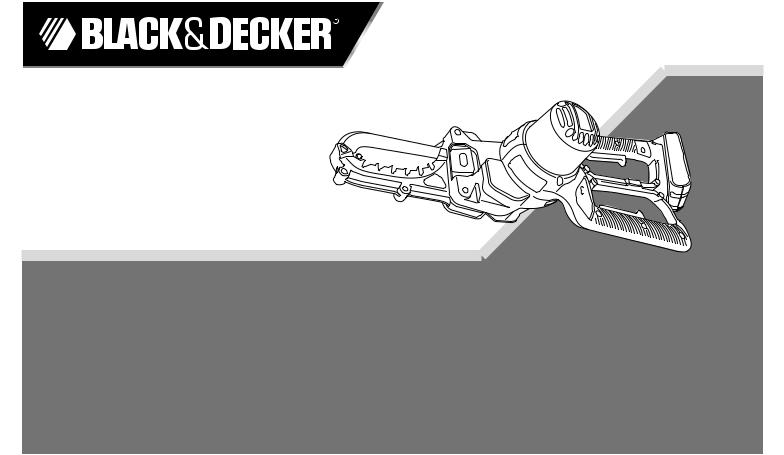
ÉBRANCHEUR ALLIGATOR LOPPER AVEC BLOC-PILES AU LITHIUM, 20 V MAX.*
MANUEL D’ INSTRUCTIONS
Numéro de modèle
LLP120
Voici des renseignements importants qu’il vous
•NE PAS EXERCER DE TENSION TROP FORTE SUR LA CHAINE. Se reporter au chapitre « REGLAGE de la tension de la chaîne » pour savoir comment tendre la chaîne correctement.
•Resserrer la chaîne fréquemment lors des deux premières heures d’utilisation pour que celle-ci s’adapte.
Merci d’avoir choisi Black & Decker! Consulter le site Web www.BlackandDecker.com/NewOwner pour enregistrer votre nouveau produit.
à LIRE avant de retourner ce produit pour quelque raison que ce soit:
Si des questions ou des problèmes surgissent après l’achat d’un produit Black & Decker, consulter le site Web www.blackanddecker.com/instantanswers
pour obtenir des réponses instantanément 24 heures par jour. Si la réponse est introuvable ou en l’absence d’accès à l’Internet, composer le 1 800 544-6986 de 8 h à 17 h HNE, du lundi au vendredi, pour parler avec un agent. Prière d’avoir le numéro de catalogue sous la main lors de l’appel.
Pour l´achat d´un filtre de rechange composer le 1-888-678-7278
CONSERVER CE MODE D’EMPLOI POUR UN USAGE ULTÉRIEUR.
*La tension initiale maximale du bloc-piles (mesurée sans charge de travail) est de 20 volts. La tension nominale est de 18.
17
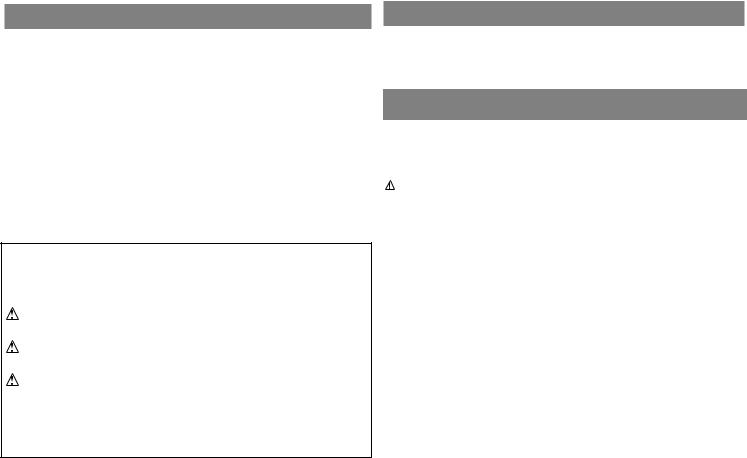
TABLE DES MATIÈRES |
|
Directives de sécurité - Définitions........................................... |
18 |
Règles de sécurité importantes ............................................... |
18 |
Importantes directives de sécurité pour |
|
les chargeurs de piles............................................................... |
23 |
Composantes........................................................................... |
24 |
Importantes directives de sécurité pour les blocs-piles............ |
25 |
Procédure de charge................................................................ |
26 |
Installation/dépose du bloc-piles.............................................. |
27 |
Préparation pour l’utilisation de votre |
|
Ébrancheur Alligator LopperMC .................................................. |
27 |
Fonctionnement........................................................................ |
29 |
Entretien................................................................................... |
30 |
Accessoires.............................................................................. |
33 |
Information sur les réparations................................................. |
33 |
Dépannage............................................................................... |
34 |
Garantie limité de deux ans pour une |
|
utilisation domestique............................................................... |
35 |
Utilisation prÉvue
Votre ébrancheur Alligator Lopper MC Black & Decker a été conçu pour élaguer les arbres et couper de petits rondins pouvant aller jusqu’à 100 mm (4 pouces) de diamètre. Cet outil se destine uniquement à être utilisé par les consommateurs.
DIRECTIVES DE PREMIÈRE IMPORTANCE
 AVERTISSEMENT :Lire toutes les directives. Tout manquement aux directives suivantes pose des risques de choc électrique, d’incendie et/ou de blessure grave.
AVERTISSEMENT :Lire toutes les directives. Tout manquement aux directives suivantes pose des risques de choc électrique, d’incendie et/ou de blessure grave.
LIRE TOUTES CES DIRECTIVES. Consignes de sécurité et avertissements pour les scies à chaîne
• Conserver la zone de travail propre
Les zones encombrées favorisent les blessures. Démarrer la coupe uniquement après avoir dégagé la zone de travail, avoir un bon équilibre et prévoir une voie de retrait lors de la chute de l’arbre.
• Penser à l’environnement de la zone de travail
Être extrêmement prudent lors de la coupe de broussailles ou de jeunes arbres, car les branches élancées peuvent se coincer dans la chaîne et être projetées vers vous ou vous déséquilibrer. Lors de la coupe d’une branche maîtresse sous tension, prendre garde à la détente lorsque la tension contenue dans les fibres de bois se relâche et que la branche risque de frapper l’utilisateur. Protéger la scie à chaîne contre la pluie et la neige. Ne pas utiliser la scie à chaîne dans des endroits humides ou mouillés ou sous la pluie ou
la neige. Ne pas utiliser la scie à chaîne en présence de liquides ou de gaz inflammables ou de poussières concentrées dans un milieu clos. Couper uniquement s’il est possible de bien voir en présence d’une luminosité suffisante
• Éloigner les enfants, les curieux, les visiteurs et les animaux
Empêcher les visiteurs de toucher à la scie à chaîne. Tous les visiteurs doivent être tenus à l’écart de la zone de travail.
18 • Ranger la scie à chaîne inutilisée
